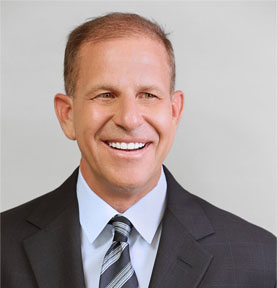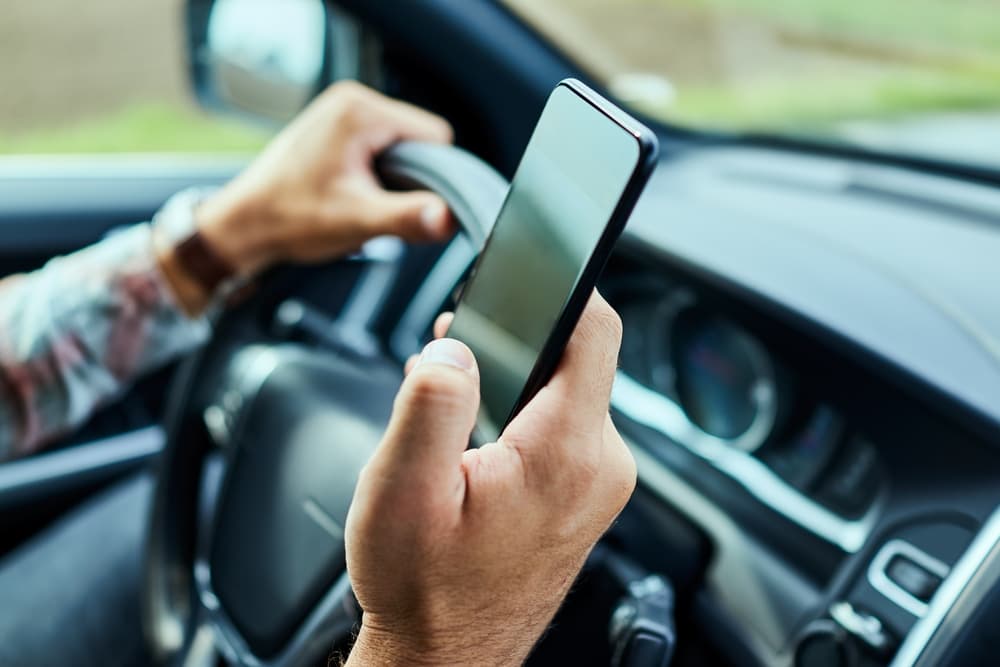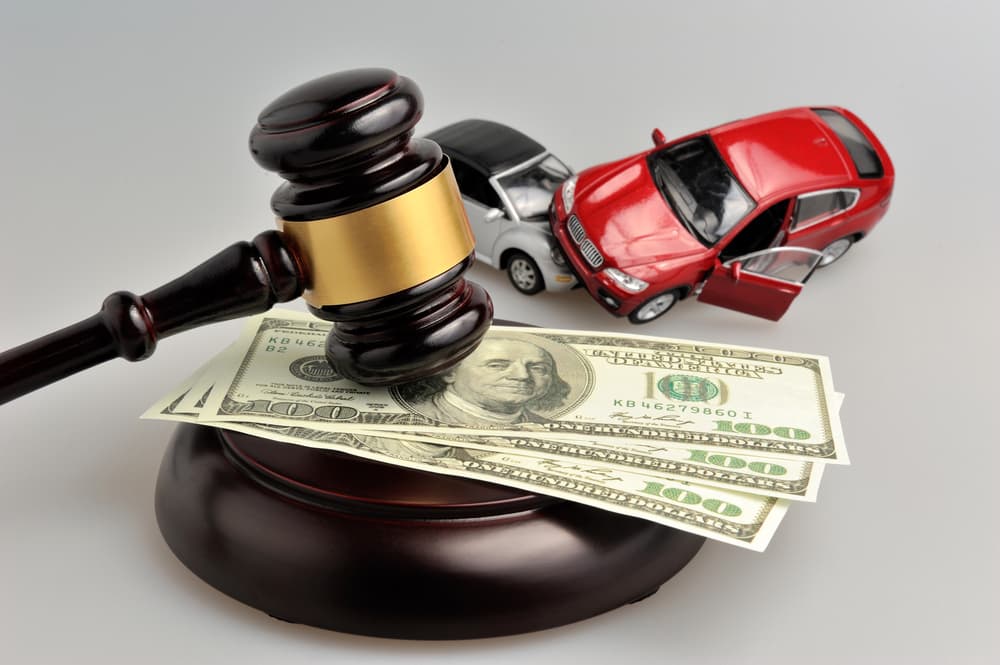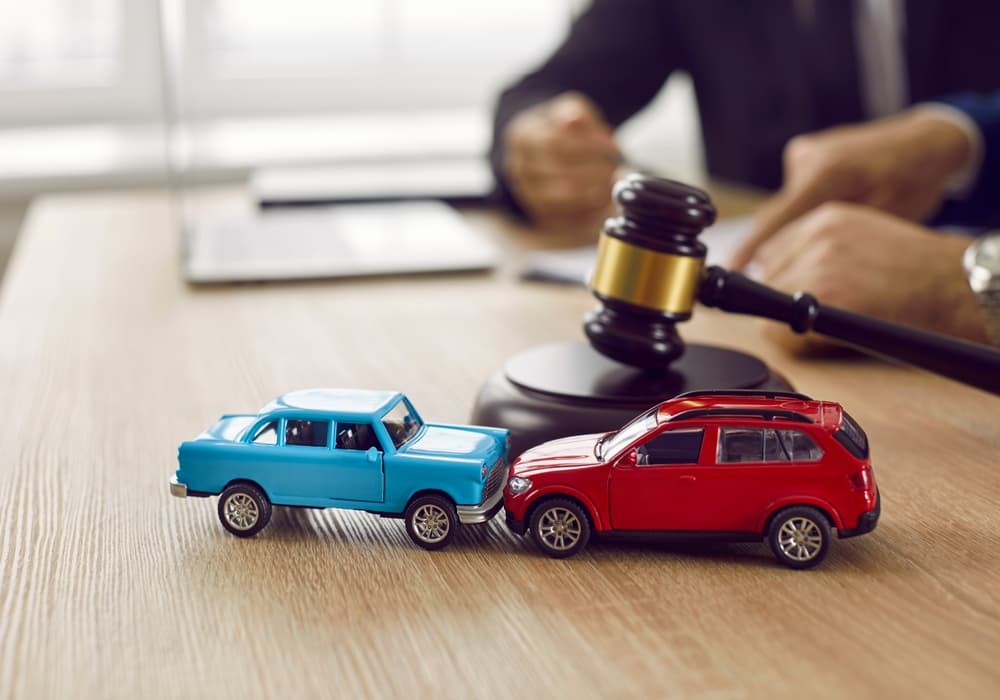The most common driving distractions fall into three categories: visual (eyes off the road), manual (hands off the wheel), and cognitive (mind off driving). Texting combines all three, making it particularly dangerous, but everyday habits like adjusting GPS, eating, managing passengers, and glancing at roadside activity also cause thousands of crashes across California each year.
Distracted driving turns routine commutes into collision risks. Olan Law handles car accident claims throughout Santa Monica and Southern California, securing phone records, app logs, dashboard-camera footage, and witness statements to prove distraction when at-fault drivers deny responsibility.
Contact for a Free Consultation
Key Takeaways for Common Driving Distractions in California
- Visual, manual, and cognitive distractions reduce your ability to respond to sudden stops, lane changes, pedestrians, and cyclists—three seconds of inattention at 60 mph means traveling the length of a football field blind.
- Texting remains the deadliest distraction because it engages eyes, hands, and mind simultaneously, and California law bans handheld phone use with steep fines and points for violations.
- Hands-free calls and voice commands are legal but still cognitively distracting, slowing reaction times and reducing situational awareness even when your eyes stay on the road.
- In-car technology like GPS, infotainment screens, and dashboard apps creates visual and manual distraction that rivals or exceeds phone use, particularly during complex navigation or music selection.
- Passengers, children, pets, eating, grooming, and roadside activity contribute to distraction-related crashes, and proving another driver was distracted requires phone records, witness accounts, and collision reconstruction.
What Are the Three Main Types of Driver Distraction?
Driver distractions are classified into three categories based on how they impair your ability to operate a vehicle safely. Many distractions combine two or all three types. Texting is particularly dangerous because it requires visual attention to read the screen, manual effort to type, and cognitive focus to compose or understand messages, all of which simultaneously pull your full attention away from driving.
Visual Distractions
Visual distractions pull your eyes away from the road. Examples include reading texts, checking GPS, glancing at passengers, adjusting mirrors, looking at billboards, or rubbernecking at roadside incidents. Even a brief two- or three-second visual distraction eliminates your ability to see brake lights, pedestrians, or lane changes ahead.
Manual Distractions
Manual distractions remove your hands from the steering wheel. Texting, eating, drinking, adjusting climate controls, reaching for objects, grooming, smoking, or petting an animal forces you to steer with one hand or none, reducing control and increasing crash risk during sudden maneuvers.
Cognitive Distractions
Cognitive distractions occupy your mental attention. Daydreaming, hands-free phone conversations, stress, emotional distress, or complex problem-solving diverts focus from driving tasks. You might look at the road without processing what you see, missing hazards until it’s too late to react.
What Does California Law Say About Phone Use While Driving?
California enforces strict prohibitions on handheld phone use while driving under Vehicle Code § 23123.5. Key provisions include:
- Drivers may not hold or operate a phone while driving; any texting, calling, browsing, or using apps requires hands-free operation.
- Phones must be mounted on the windshield, dashboard, or console and activated with a single swipe or tap if drivers choose to use them.
- Voice-operated systems are permitted but must not require manual input beyond initial activation.
- Drivers under 18 cannot use any wireless device, even hands-free, except in emergencies under Vehicle Code § 23124.
Violations carry fines starting at $20 for first offenses and $50 for subsequent violations, with total costs exceeding $150 after penalty assessments. More importantly, handheld phone use violations create a record that insurers and attorneys use in crash claims to establish liability.
Is Texting the Most Dangerous Distraction While Driving?
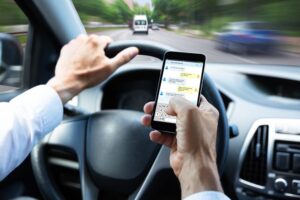 Texting ranks as the most dangerous distraction because it engages all three distraction types at once. According to the National Highway Traffic Safety Administration, sending or reading a text takes your eyes off the road for an average of five seconds—long enough to cross an entire football field at highway speed without seeing where you’re going.
Texting ranks as the most dangerous distraction because it engages all three distraction types at once. According to the National Highway Traffic Safety Administration, sending or reading a text takes your eyes off the road for an average of five seconds—long enough to cross an entire football field at highway speed without seeing where you’re going.
Despite laws prohibiting the use of handheld devices, texting-related crashes remain common on California roads. Drivers underestimate how quickly conditions change. A pedestrian steps into a crosswalk, traffic stops suddenly, or a vehicle merges without warning. Five seconds of screen time eliminates any chance to respond.
In car accident claims, attorneys may subpoena phone records, app usage logs, and carrier data to prove a driver was texting at the time of the collision. This evidence establishes liability when the at-fault driver denies distraction.
Are Hands-Free Calls Still Distracting?
Hands-free calls are legal in California for drivers over 18, but remain cognitively distracting. Research shows that even when your eyes stay on the road and your hands stay on the wheel, engaging in phone conversations reduces reaction time, narrows your field of visual attention, and impairs hazard recognition.
The cognitive load of processing conversation, formulating responses, and holding context in working memory diverts mental resources from driving tasks. You might stare at the road without truly seeing it, a phenomenon called “inattention blindness.” Drivers in hands-free conversations miss traffic signals, fail to check mirrors, and respond more slowly to brake lights or pedestrians.
If you’re in a collision caused by a driver who was on a hands-free call, proving distraction requires phone records showing call duration and timing, witness testimony about the driver’s behavior before impact, and reconstruction evidence demonstrating the driver’s delayed response.
Contact for a Free Consultation
Do GPS and Infotainment Screens Count as Distractions?
GPS navigation systems, infotainment touchscreens, and dashboard displays are significant sources of distraction. These systems demand visual attention to read maps, select destinations, adjust audio, or respond to prompts, pulling your eyes from the road for several seconds at a time.
California law allows GPS use while driving, but the device must be mounted on the windshield, dashboard, or center console in a way that does not obstruct the driver’s view, per Vehicle Code §23123.5. Holding a GPS device or phone for navigation violates handheld-use prohibitions.
Modern vehicles integrate navigation and entertainment into complex infotainment systems that require multiple taps, swipes, or voice commands to operate. Searching for a destination, scrolling through music playlists, or reading notifications introduces visual and manual distraction comparable to texting.
Even voice-activated systems create cognitive distraction. Issuing commands, correcting misunderstood prompts, and processing audio feedback occupy mental resources better spent monitoring traffic, checking mirrors, and anticipating other drivers’ actions.
If a distracted driver causes a crash while programming GPS or adjusting infotainment settings, attorneys examine dashboard cameras, vehicle event-data recorders, and witness accounts to document the distraction and establish fault.
Which Everyday Habits Are Most Risky While Driving?
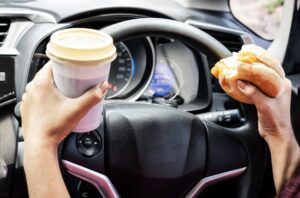 Everyday activities that seem harmless introduce visual, manual, and cognitive distractions that increase crash risk:
Everyday activities that seem harmless introduce visual, manual, and cognitive distractions that increase crash risk:
- Eating and drinking require you to unwrap food, hold items, manage spills, and glance away from the road. Hot beverages and messy foods create additional hazards if they spill, prompting sudden reactions that jerk the wheel or slam brakes unexpectedly.
- Grooming and personal care, like applying makeup, shaving, combing hair, and adjusting clothing, demand mirror use and fine motor control that removes hands from the wheel and eyes from traffic. These tasks are particularly risky during morning commutes when drivers rush to finish preparing for work.
- Smoking and vaping involve lighting, ashing, holding devices, and managing smoke or vapor, all of which create manual and visual distraction. Dropped cigarettes or vape pens cause panic reactions that lead to swerving or sudden braking.
- Reaching for objects, such as phones, wallets, sunglasses, and bags, forces drivers to look away, lean, stretch, or unbuckle, reducing vehicle control. Items that roll under seats or fall between seats tempt drivers to retrieve them while moving, compounding the danger.
- Adjusting vehicle controls, like climate, mirrors, seats, and radio, takes attention from driving. Complex adjustments or unfamiliar controls in rental or new vehicles increase time spent looking away from the road.
California does not have specific statutes banning eating, grooming, or smoking while driving, but these activities can support reckless driving or negligence claims if they contribute to a collision. Vehicle Code § 23103 prohibits driving with willful disregard for safety, which may apply when distraction causes a crash.
How Do Passengers, Kids, and Pets Contribute to Distraction?
Passengers, children, and pets introduce distractions that many drivers underestimate:
Adult Passengers
Adult passengers engage drivers in conversation, point out roadside sights, adjust the music or climate controls, and sometimes criticize or offer backseat driving advice. While conversation is natural, complex or emotional discussions create cognitive distraction that slows reaction time and narrows attention.
Minor Passengers
Children require frequent monitoring, especially infants and toddlers. Crying, dropped toys, sibling arguments, or requests for snacks and entertainment pull visual and cognitive focus from driving.
Turning to address children in rear seats forces drivers to look away from the road for extended periods.
Pets
Pets move unpredictably in vehicles, sometimes climbing onto laps, blocking pedals, or jumping between seats. Unrestrained animals pose serious distraction and injury risks. A startled dog or cat can cause a driver to swerve or brake suddenly, triggering crashes.
California law does not require pet restraints, but Vehicle Code § 23117 prohibits driving with an animal in the driver’s lap, recognizing the obstruction and distraction it creates.
Proving another driver was distracted by passengers or pets relies on witness statements, dashboard or traffic-camera footage showing the driver’s attention directed inside the vehicle, and reconstruction analysis demonstrating delayed or absent braking before impact.
What Evidence Proves Another Driver Was Distracted?
 Strong evidence of distraction is crucial for securing a fair settlement. Establishing distraction in a car accident claim requires multiple forms of evidence, such as:
Strong evidence of distraction is crucial for securing a fair settlement. Establishing distraction in a car accident claim requires multiple forms of evidence, such as:
- Phone records and app logs show call timing, text messages, app usage, and data transmission at the collision time. Subpoenas compel carriers and app providers to release this information.
- Witness statements describe the at-fault driver’s behavior before impact, including head down, eyes on a device, erratic steering, delayed braking, or hands occupied with food or other objects.
- Dashboard and traffic-camera footage captures the driver’s actions inside the vehicle, providing visual proof of phone use, eating, or other distractions.
- Vehicle event-data recorders (black boxes) document speed, braking, steering input, and throttle position in the seconds before a crash, revealing whether the driver attempted to avoid the collision.
- Police reports note officer observations, citations for handheld phone use, and driver admissions about distraction.
- Collision reconstruction analysis, when warranted, establishes that the driver’s failure to brake, swerve, or slow indicates inattention, consistent with distraction rather than mechanical failure or intentional conduct.
A car accident attorney coordinates these investigative steps, subpoenas records, interviews witnesses, and retains experts, if needed, to build a comprehensive case proving the at-fault driver’s distraction caused your injuries.
FAQ About Distracted Driving in California
Can I Be Held at Fault If a Passenger Distracted Me?
Yes. California law holds drivers responsible for maintaining control and attention regardless of passenger behavior, so a distracted passenger doesn’t eliminate your liability if you cause a crash.
Are Smartwatches and Earbuds Legal While Driving in California?
Smartwatches fall under handheld-device prohibitions if you interact with the screen while driving, and wearing both earbuds is illegal under Vehicle Code § 27400, which permits only one ear covered.
Does Rubbernecking Count as Distracted Driving?
Yes. Slowing to look at crashes, police stops, or roadside activity is a visual distraction that causes secondary collisions, and drivers who rear-end stopped traffic while rubbernecking are liable for resulting injuries.
Can Dashboard Cameras Prove I Wasn’t Distracted?
Dashboard cameras that record both the road and driver compartment provide powerful evidence showing you were attentive, not using devices, and reacted appropriately when another driver caused the crash.
What Should I Do If a Distracted Driver Hits Me?
Seek medical care immediately, photograph the scene and vehicles, collect witness contact information, report the crash to police, and contact an attorney before giving recorded statements to insurers.
Hit by a Distracted Driver in Santa Monica?

Distracted driving crashes happen fast on PCH, Ocean Avenue, and Santa Monica’s busy corridors. Proving another driver was texting, adjusting GPS, or looking away from the road requires phone records, witness accounts, and collision reconstruction.
Olan Law gathers this evidence, coordinates with experts, when needed, and handles insurer negotiations while you focus on recovery.
Call (310) 566-0010 for a free consultation. Our reliable car accident lawyers offer friendly guidance, straight answers, and no upfront costs.
